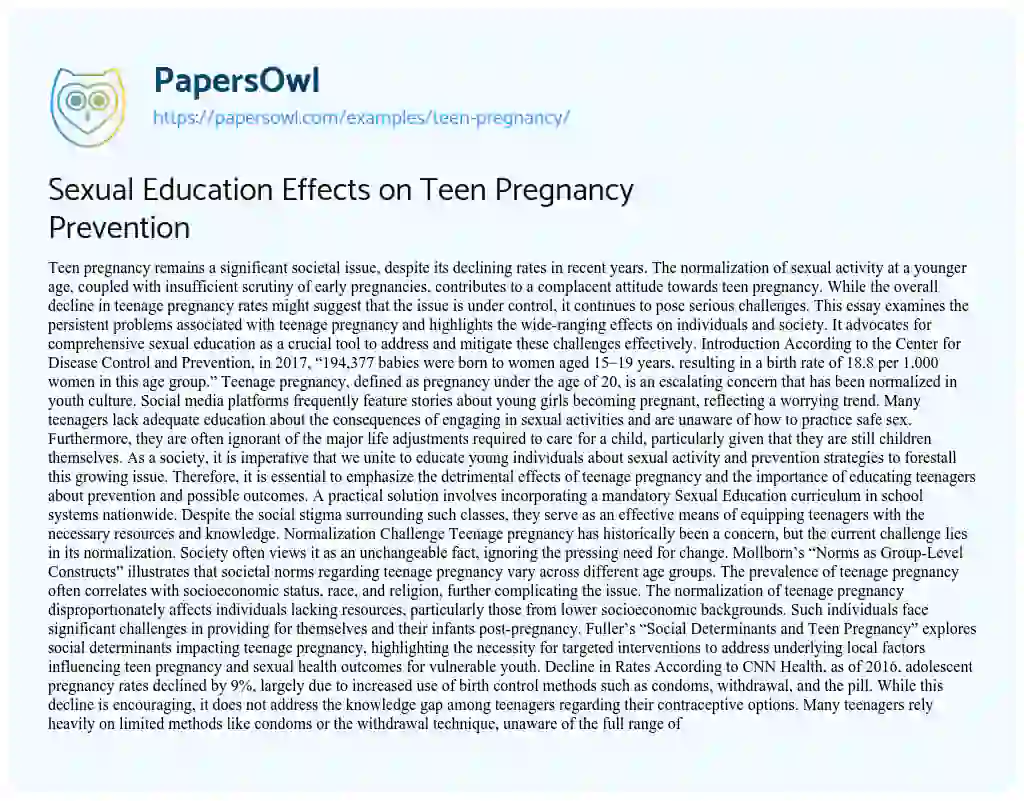
Teen Pregnancy: A Comprehensive Overview
Introduction
Teen pregnancy, defined as pregnancy occurring in individuals between the ages of 13 and 19, remains a significant public health concern worldwide. Despite efforts to reduce its prevalence, teen pregnancy continues to have far-reaching consequences for both the young mothers and their children. This paper aims to provide a comprehensive overview of teen pregnancy, examining its causes, consequences, and potential interventions.
Causes of Teen Pregnancy
The causes of teen pregnancy are multifaceted and complex, involving both individual and societal factors. Some of the most commonly identified risk factors include:
- Early sexual initiation: Adolescents who engage in sexual activity at a young age are more likely to become pregnant.
- Lack of access to contraception: Limited access to effective contraception, such as condoms and birth control pills, increases the risk of unplanned pregnancy.
- Peer pressure: Adolescents who have friends or peers who are sexually active or pregnant are more likely to engage in risky sexual behaviors.
- Family dysfunction: Teenagers from families with low parental involvement, high levels of conflict, or substance abuse are at increased risk for teen pregnancy.
- Socioeconomic factors: Poverty, lack of education, and limited employment opportunities can contribute to teen pregnancy by reducing access to resources and support.
Consequences of Teen Pregnancy
Teen pregnancy has numerous negative consequences for both the young mothers and their children.
For the Young Mothers:
- Increased health risks: Teen mothers are at higher risk for pregnancy-related complications, such as premature birth, low birth weight, and postpartum depression.
- Educational challenges: Teen pregnancy often leads to school dropout or delayed graduation, limiting future educational and career opportunities.
- Economic hardship: Teen mothers are more likely to experience poverty and unemployment, which can impact their ability to provide for themselves and their children.
- Social stigma: Teen mothers may face social isolation, discrimination, and judgment, which can negatively impact their mental health and well-being.
For the Children:
- Health disparities: Children born to teen mothers are more likely to have health problems, such as low birth weight, developmental delays, and chronic diseases.
- Cognitive and behavioral challenges: Children of teen mothers may experience cognitive and behavioral problems, including learning disabilities, attention deficit hyperactivity disorder (ADHD), and conduct disorders.
- Social and emotional difficulties: Children of teen mothers may have difficulty forming healthy relationships, coping with stress, and achieving academic success.
Interventions to Reduce Teen Pregnancy
Numerous interventions have been developed to reduce teen pregnancy rates. These interventions typically focus on addressing the underlying causes of teen pregnancy and providing support and resources to young people. Some of the most effective interventions include:
- Comprehensive sex education: Providing adolescents with accurate and age-appropriate information about sexual health, contraception, and decision-making can help them make informed choices about their sexual behavior.
- Access to contraception: Ensuring that adolescents have access to affordable and confidential contraception is essential for preventing unplanned pregnancy.
- Peer support programs: Programs that connect adolescents with peers who are committed to healthy sexual behaviors can provide support and encouragement.
- Family-based interventions: Interventions that involve parents and families in addressing teen pregnancy risk factors can improve communication, support, and decision-making within the family.
- Community-based programs: Community-based programs that provide a range of services, such as after-school programs, mentoring, and job training, can help address the social and economic factors that contribute to teen pregnancy.
Conclusion
Teen pregnancy remains a complex and multifaceted issue with significant consequences for both the young mothers and their children. Understanding the causes and consequences of teen pregnancy is crucial for developing effective interventions to reduce its prevalence. By addressing the underlying risk factors, providing support and resources to young people, and promoting healthy sexual behaviors, we can work towards creating a future where teen pregnancy is no longer a barrier to success and well-being.